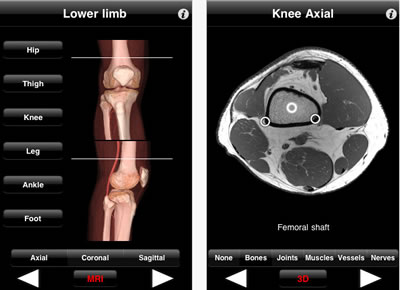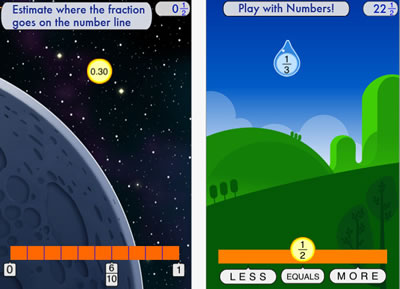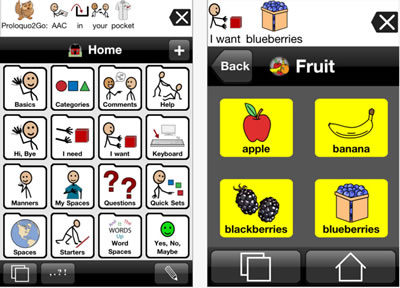E School News Top 10 Apps for Apple Devices
One app teaches young students about cyber bullying.
Last year we presented “10 of the best apps for education,” which highlighted some of the best apps for iPhones and iPods. However, with new upgrades in touch technology, HD and 3D features, and the debut of the iPad, we’ve come up with a new list of the best Apple-based education apps for 2012.
This year’s list includes some of the most highly rated apps, both by teachers and by Apple, and features a range that spans from simple math games to a revolutionary special-education app, and from 3D imaging of the elements included in the periodic table to secure file sharing for students and teachers.
For every app we’ve listed, we’ve included a brief description, device compatibility, suggested use, features, price, and a link to a more in-depth summary with an option to purchase on iTunes.
Don’t see an app you love on this list? Be sure to let us know—or leave a suggestion in the comment section.
Name: Edmodo
What is it? Edmodo makes it easy for teachers and students to stay connected and share information.
Best for: High school students; iPhone, iPod, iPad
Price: Free
Rated: 4+
Features: Send notes; submit assignments; post replies; check messages and upcoming events while away from the classroom; teachers can post last-minute alerts to their students, keep tabs on recent assignment submissions, and grade assignments; students can view and turn in assignments and check their latest grades.
Link: http://itunes.apple.com/us/app/edmodo/id378352300?mt=8
Name: Frog Dissection
What is it? This app is a greener alternative for teaching dissection in the classroom. It’s suitable for middle school students who are learning about organs and organ systems as part of their life science curriculum.
Best for: Science; Biology; iPad
Price: $3.99
Rated: 4+
Features: 3D imaging; step by step instructions with voice over; accurate simulation of the wet lab dissection procedure; content validation by subject matter experts; anatomical comparison of humans with frogs; comprehensive information on frogs’ organs; classification, lifecycle, and organ functions of frogs; interactive quiz on frogs; information on types of frogs.
Link: http://itunes.apple.com/us/app/frog-dissection/id377626675?mt=8
Name: Grammar Up HD
What is it? Improve grammar and vocabulary with this multiple-choice quiz system featuring more than 1,800 questions in 20 categories.
Best for: English/Language Arts; iPad
Price: $4.99
Rated: 4+
Features: More than 1,800 multiple-choice questions; choose number of questions you would like in each test; shows test results in HTML format; eMail yourself the test results and track your progress; “Progress Meter” keeps track of how you are performing in a particular topic; choose your own timer settings.
Link: http://itunes.apple.com/us/app/grammar-up-hd/id406782226?mt=8&ign-mpt=uo%3D4
Name: History: Maps of the World
What is it? Browse high-resolution maps of the world from various periods throughout history.
Best for: History, Geography; iPhone, iPod, iPad
Price: Free
Rated: 4+
Features: Wide variety of historical displays; support for Category/Era view; keyword search; displays the source about each map; zoom in/out (zoom in/out with pinch, zoom in with double tab, and zoom out with two-fingers tap); free screen rotation; does not require a network connection.
Link: http://itunes.apple.com/us/app/history-maps-of-world/id303282377?mt=8
Name: iStudiez Pro
What is it? Organize your class schedule, keep track of homework assignments, record your GPA, make to-do lists, and more with this app created for a busy student’s life.
Best for: High school students; iPhone, iPod, iPad
Price: $2.99
Rated: 4+
Features: Students are able to follow up with homework; summarizing schedules and assignments; tracking grades and GPA; push notifications; backup data options.
Link: http://itunes.apple.com/app/istudiez-pro/id310636441?ign-mpt=uo%3D4&mt=8
Name: Monster Anatomy
What is it? Explore 384 contiguous MR slices in the three anatomical planes with this interactive lower-limb radiology atlas.
Best for: Biology; iPhone, iPod, iPad
Price: $8.99
Rated: 4+
Features: Navigation with multiple shortcuts; display of images in the three anatomical planes; 3D image volume (VR) allows precise location of slice position; over 500 different labels in accordance with the “Terminologia Anatomica” and current literature references; more than 10,000 tags; the five different display modes available (bones, joints, muscles, blood vessels, and nerves) facilitate label visualization; high image quality with a zooming tool.
Link: http://itunes.apple.com/us/app/monster-anatomy-lower-limb/id358915264?mt=8&ign-mpt=uo%3D4
Name: Motion Math
What is it? Motion Math HD follows a star that has fallen from space and must bound back up, up, up to its home in the stars. Moving fractions to their correct place on the number line is the only way to return. By playing Motion Math, learners improve their ability to perceive and estimate fractions in multiple forms.
Best for: Math; iPhone, iPod Touch, iPad
Price: $1.99
Rated: 4+
Features: Problem hints; intro level, practice of improper fractions and negative decimals; beginner, medium, and expert modes; bonus levels.
Link: http://itunes.apple.com/us/app/motion-math/id392489333?mt=8
Name: Professor Garfield Cyberbullying
What is it? Teach kids anti-bullying messages and strategies for dealing with cyber bullies with the help of Garfield and friends.
Best for: Internet safety; elementary students; iPad
Price: Free
Rated: 4+
Features: Understand the meaning of cyber bully; learn to recognize different forms of cyber bullying; learn different strategies for dealing with a cyber bully; learn the importance of enlisting the help of a trusted adult when cyber bullied.
Link: http://itunes.apple.com/us/app/professor-garfield-cyberbullying/id369171501?mt=8
Name: Proloquo2go
What is it? This easy-to-use alternative communication solution offers an extensive library of symbols for those who have difficulty speaking. It provides natural sounding text-to-speech voices, high-res up-to-date symbols, automatic conjugations, a default vocabulary of more than 7,000 items, advanced word prediction, full expandability; and extreme ease of use. For anyone who cannot afford spending thousands of dollars on an AAC device and yet wants a solution that is just as good if not better. SLPs, teachers, and parents recommend it for children and adults with autism, cerebral palsy, down syndrome, developmental disabilities, apraxia, ALS, stroke, or traumatic brain injury.
Best for: Special education; iPhone, iPod, iPad
Price: $189.99
Rated: 4+
Features: Listed above; educational institutions can get a 50-percent discount on Proloquo2Go if they purchase 20 or more licenses through Apple’s Volume Licensing Program for Education.
Link: http://itunes.apple.com/app/proloquo2go/id308368164?ign-mpt=uo%3D4&mt=8
Name: The Elements: A Visual Exploration
What is it? Learn about the periodic table in a hands-on way. Choose any element—copper, for example—and see various copper objects: a Persian weave chain, a brass ring, a Chinese bronze … and then rotate them with your finger to get a 3D view.
Best for: Science; Chemistry; iPad
Price: $13.99
Rated: 4+
Features: Sharp HD images that can rotate (available in 3D); columns of facts and figures with each element; Wolfram Alpha computational knowledge engine.
Link: http://itunes.apple.com/us/app/elements-visual-exploration/id364147847?mt=8
How to fix the charter school movement (and what Albert Shanker really said) let Jeff Piontek know….
Chris Cerf, the acting commissioner of education in New Jersey, published an article today defending charter schools, which have become very controversial in his state. They have become controversial because the state is trying to push them into suburbs that have great public schools and don’t want them, and they have become controversial because the public is beginning to revolt against for-profit charters, especially for-profit online charters, which Cerf is promoting.

People in New Jersey are beginning to realize that every dollar that goes to a privately managed charter school is a dollar taken away from
their own public school. Because the budget is not expanding, it IS a zero sum game. Fixed costs do not decline when children leave the school.
Despite Governor Chris Christie’s frequent belittling of New Jersey teachers and schools, New Jersey is one of the highest performing states in the nation on the federal National Assessment of Educational Progress. So, citizens of the state have good reason to oppose the Christie administration’s efforts to turn more taxpayer dollars over to private entrepreneurs.
In his article, Chris Cerf writes:
…it is often forgotten that one of the first advocates for public charter schools was Albert Shanker, the former New York City teachers’ union leader, who supported charter schools as a way to empower public school educators to innovate.
Chris Cerf needs to know what Albert Shanker really said about charter schools. This is what he would learn if he read pp. 122-124 of my book “The Death and Life of the Great American School System:”
1. Albert Shanker was president of the American Federation of Teachers, not the New York City union, when he first proposed the charter school idea in 1988.
2. Shanker proposed that any new charter should be jointly approved by the union and the school district. More than 90% of charters today are non-union. Shanker would not have approved any school that did not respect the rights of teachers to bargain collectively.
3. Shanker proposed that new charters should target the hardest-to-educate students: those who had dropped out or were failing. He never imagined that charters would have a selection process or that charters might avoid students with disabilities or English-language learners as is now the case in many charters.
3. Shanker wanted charters to collaborate, not compete, with existing public schools. He proposed them as a way to solve the problems of public schools. Whatever they learned, he said, should be shared with the public schools that sponsored them.
4. MOST IMPORTANT: In 1993, when Shanker saw that the charter idea was going to be used to privatize public education, he turned against charter schools. He opposed the takeover of the charter idea by corporations, entrepreneurs, and for-profit vendors. He became a vocal opponent of charter schools when he realized that his idea was embraced by “the education industry.” In his weekly column in The New York Times, Albert Shanker repeatedly denounced charter schools, vouchers, and for-profit management as “quick fixes that won’t fix anything.”
Here is an idea for Commissioner Cerf. You can fix the charter idea if you align it with Shanker’s original idea.
First, insist that all new charters are endorsed by the local school district and the union representing teachers.
Second, bar all for-profit management.
Third, insist that all charters recruit and enroll only the lowest-performing students, the students who have dropped out, and the students who are doing poorly in their present public school.
Fourth, require that charters collaborate with the public schools and share whatever they learn.
Fifth, to truly revive the spirit of Shanker’s proposal, bar all corporate-owned charter chains. Authorize only stand-alone charters that are created by teachers and parents in the district to serve the children of that district. No chains, just local charters committed to that community.
So, yes, Commissioner Cerf, you are on the right track when you quote Albert Shanker. Now, if you take his advice, you can save the charter school idea from the privatizers and profiteers who are giving it a bad name.
Check out these sites if you are looking for education App’s by Jeff Piontek
Fortunately enough, in this age of wired comunication and cloud based connections nothing is hard to get anymore. There are now several platforms designed specifically to meet teachers and students needs in using mobile devices in education. These websites are, most of the time, created and run by educators and provide reviews of awesone apps to use for learning. I have compiled a list of these resources for you to bookmark and access whenever you want to look for a certain app to share with students.
1- Educational technology and Mobile Learning

2- One Place for Special Needs
This website provides a detailed app guide for special needs families, speech therapists, occupational therapists, social workers and teachers.
This app offers a multiple resources to support teachers and parents in their search for free quality apps for their children and students.
6- Kinder Town

Kinder Town transforms mobile devices into powerful teaching tools by finding and organizing the best educational apps for kids ages 3-8 years old.
7- Moms with Apps

This website supports family-friendly developers seeking to promote quality apps for kids
8- Bridging apps

This is a volunteer community of parents, therapists, doctors, and teachers who share information on how we are using the iPad, iPhone, iPod Touch and Android devices with people who have special needs.
This is a website where you can discover the best iPhone, iPod Touch and iPad apps for kids.
11- iPads in Schools

This is a livebinder that contains several awesome resources on educational apps for teachers, students parents, administrators and many more.
iPads for Education features some of the best educational apps available for teachers and students. It has a great interface and all apps are organized into categories for easy navigation.
14- Apps in Education

This a great website for iPad apps that teachers and students can use in their education.
Great Interview with Ray Kurzweil…..when computers and humans merge
I found this to be a great interview with one of the people I admire. He pushes the envelope on technology, human behavior and evolution. Click on the title to see interview with Ray Kurzweil.
by Jeff Piontek
Then you have the other side of the idea, where corporations are controlling the afterlife and a transitional state….funny
Community Colleges see an INCREASE in students entering with Academic Needs | In Hawaii 70% need remediation | WHY? asks Jeff Piontek
This is nothing new to anyone with a heartbeat or a pulse in education, who work in the Pre K-20 or P-12/P-16 continuum. The fact that so many students drop out of high school in 9th grade, take the GED route instead of attending classes (and some pass) and then go on to CC, and of course those who eventually graduate in 5/6 years just shows that the high school system is fatally flawed and needs to be revamped NOW.
If you want to know more about my views on this topic watch the presentation I did in 2007, yes 2007 to the entire STEM, Political and Education committees in Hawaii which showcases our data, it is disturbing.
But, you know what is even more disturbing is the fact that under our current administration, our current superintendent and our current BOE nothing has changed!!!!
This year though during the election or re-election campaigns they will though promise to do it AGAIN, promise to make things better AGAIN and unfortunately we will see in another 2/4/6 years at the end of their term what has actually been done. There are people like Linda Lingle who as Governor did more for education that her prior three Governor’s and unfortunately in a wildly Democratic State like Hawaii did not receive the credit for her attempts to move Hawaii into the national spotlight with Robotics, STEM education and partnerships with organizations like the National Governor’s Association.
Maybe someday Hawaii will have a strong, healthy, diverse economy, but not if the “Good Old Boys” network keeps on doing what they are doing, NOTHING to change it, because it benefits them.
Presentation Link: http://www.slideshare.net/jeff.piontek/an-inconvenient-reality-oct-2007-2780003
Community colleges should tailor remedial curriculum for students who are unprepared for introductory English and math courses, and in some cases, developmental classes “hinder” student progress, according to a report released by the Education Department (ED) during an April 27 virtual symposium.
ED Secretary Arne Duncan and Second Lady Jill Biden spoke to educators and students at a symposium broadcast on the internet from Montgomery College in Silver Spring, Md., a two-year school with more than 60,000 students on three campuses.
ED officials and educators who led sessions at the symposium outlined “bridge programs” for adult learners who want to return to college after many years in the workforce, and customizing those remedial classes that come with high costs to colleges, students, and taxpayers.
ED released the report to coincide with the symposium that said as much as 60 percent of incoming community college students enroll “in at least one developmental education course to bring their reading, writing, and mathematics skills up to college level.”
Developmental classes that help new community college students catch up with their peers can be critical to earning a degree, according to the ED report, but remedial education “may not improve students’ persistence or completion rates and, in some cases, may actually hinder their progress toward educational goals.”
A more flexible slate of remedial class options on two-year campuses would have educators pinpoint precisely where a student needs improvement, said Shanna Smith Jaggars, a senior research associate at the Community College Research Center in New York.
Targeting specific academic vulnerabilities, Smith Jaggars said, would allow a student to move through remedial classes quickly without redundant lessons that lead to high drop-out rates among remedial students.
“We need a system that diagnoses student weaknesses and determines which areas require quick redress [that] gives students less opportunity to get disheartened and a chance to drop out,” she said.
Early intervention was stressed by several speakers who addressed remedial classes in community colleges. College officials and policy analysts said summer bridge programs would help high school students prepare for college without having to enroll in non-credit-bearing remedial courses.
Duncan and Biden, as they have since President Obama entered the White House in 2009, said continued help – including federal funds – for two-year colleges would help unemployed Americans find jobs and prove to be a centerpiece in the country’s economic recovery.
ED introduced the Trade Adjustment Assistance Community College and Career Training (TAACCCT) Grants Program on Jan. 20, inviting community colleges—and other two-year degree-granting institutions—to apply for up to $5 million per institution, or up to $20 million to applicants who apply for funds in a consortium of schools.
ED will dole out about $500 million in 2011, and $2 billion will be distributed in the next four years overall, according to the announcement.
“These funds will support programs that use proven or innovative strategies to prepare students for high-demand careers,” Biden said.
The Obama administration in October invited more than 100 community college decision makers to the White House’s first-ever Summit on Community Colleges, where top federal officials lauded two-year colleges as a bridge to jobs and four-year universities, and a way to lead the world in college graduates by 2020.
Education analysts said last year that the expansion of online classes at two-year colleges would be key in increasing community college enrollment.
Distance-learning enrollment in American community colleges jumped by 22 percent during the 2008-09 academic year, an increase fueled in part by an influx of nontraditional students who require the flexibility of online courses, according to a survey conducted by the Instructional Technology Council (ITC).
The ITC, which is affiliated with the American Association of Community Colleges (AACC), collected 226 responses from community colleges in its annual survey, “Trends in eLearning: Tracking the Impact of eLearning at Community Colleges,” which revealed the 2008-09 increase in online enrollment. Last year’s ITC survey reported an 11-percent uptick in web-based class enrollment at community colleges.
“We flat lined and stagnated [while] other countries have passed us by and I think we are paying a price for that,” Duncan said. “So [as we] try to educate our way to a better economy, community colleges are absolutely going to help lead us where we need to go. … Community colleges have been the unrecognized, unpolished gem on the education continuum. I believe we have come a long way to ending that.”
Biden, a longtime educator and adjunct English professor at Northern Virginia Community College, lauded the Obama administration’s $2 billion community college funding add-on to the health care reform bill passed last year.
Will this actually change anything? What are your comments I would love to know……
Thinking about starting a business by Jeff Piontek
http://www.crl3c.org/fr_
investedin – a platform built to help anyone raise money for anything, utilizing their existing social network presence
Kickstarter – a new way to fund creative ideas and ambitious endeavors and is powered by a unique all-or-nothing funding method where projects must be fully-funded or no money changes hands.
Teacher Planet – complete online resource for information related to K-12 grants.
DonorsChoose.org – an online charity that makes it easy for anyone to help students in need — public school teachers from every corner of America post classroom project requests.
crowdrise – is about volunteering, raising money for Charity and having the most fun in the world while doing it.
GiveForward – provides free, personalized fundraising pages to raise money quickly and easily online.
givezooks! – offers social fundraising for nonprofits, connecting individuals and organizations online to increase charitable giving.
Social Wish – makes it easy for individuals and not-for-profits to raise funds through social media, email marketing, and websites.
IndieGoGo – any project or idea (creative, cause or entrepreneurial) can raise money, offer perks, and keep 100% ownership of their project.





















